SNHU Report: Substance Abuse and Criminal Behavior in Prison Settings
VerifiedAdded on 2019/09/30
|7
|1431
|98
Report
AI Summary
This report analyzes the correlation between substance abuse and criminal behavior among adult prisoners over an 11-month period. The study, conducted via descriptive, cross-sectional, and random surveys, investigated the relationship between substance use (cocaine, heroin, and alcohol) and criminal activities. The research involved direct interviews with prisoners, focusing on their perceptions and experiences. The findings, based on statistical analyses of self-reported data, indicate a significant link between substance abuse and income-generating crimes, but not violent crimes. The report highlights the methodologies employed, including data collection, participant protection, and statistical analysis methods like conditional logit system analysis, to provide insights into the impact of substance use on different types of offenses within the prison population. The results indicate that substance use is associated with increased levels of crime, particularly income-generating crimes.
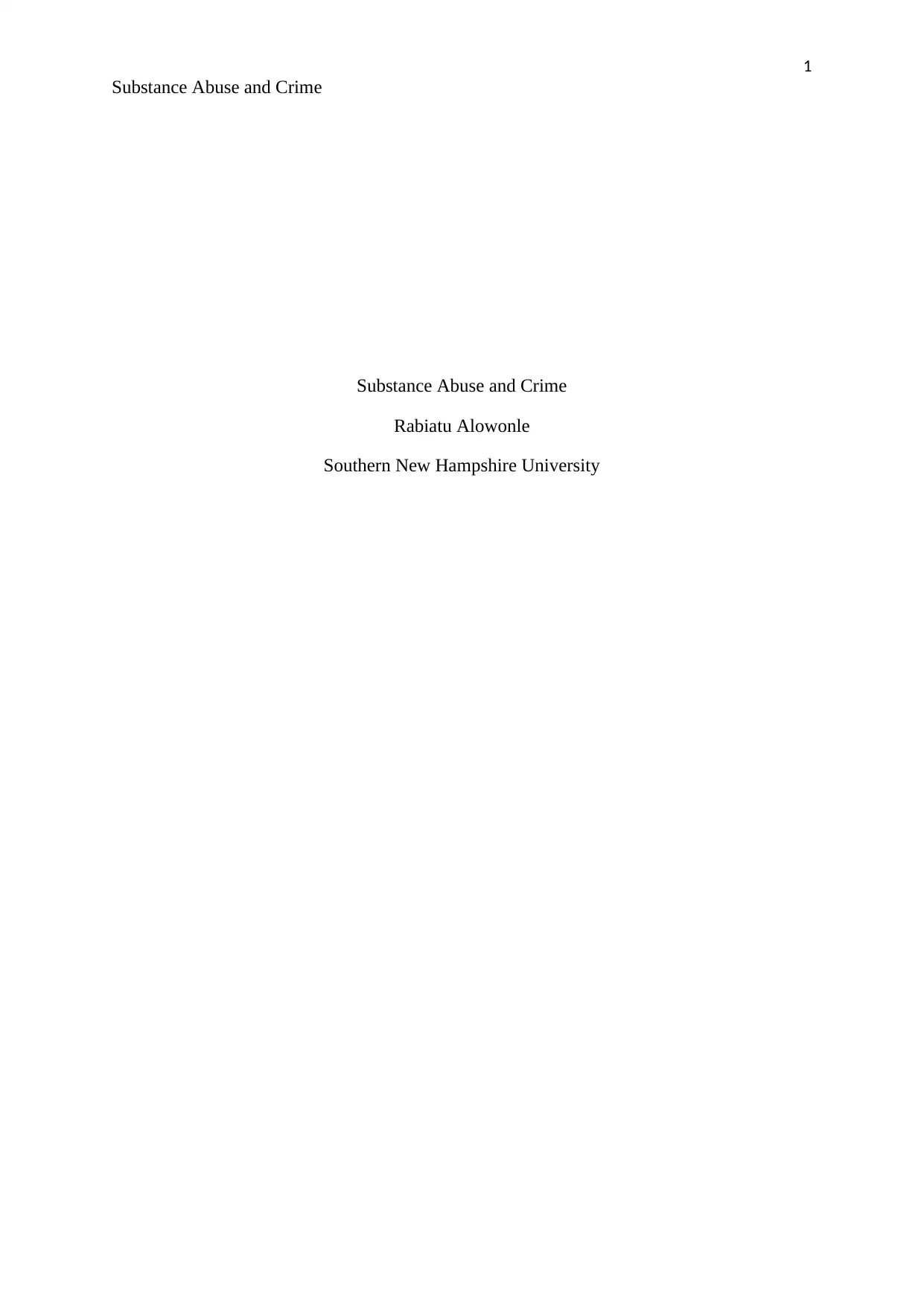
1
Substance Abuse and Crime
Substance Abuse and Crime
Rabiatu Alowonle
Southern New Hampshire University
Substance Abuse and Crime
Substance Abuse and Crime
Rabiatu Alowonle
Southern New Hampshire University
Paraphrase This Document
Need a fresh take? Get an instant paraphrase of this document with our AI Paraphraser
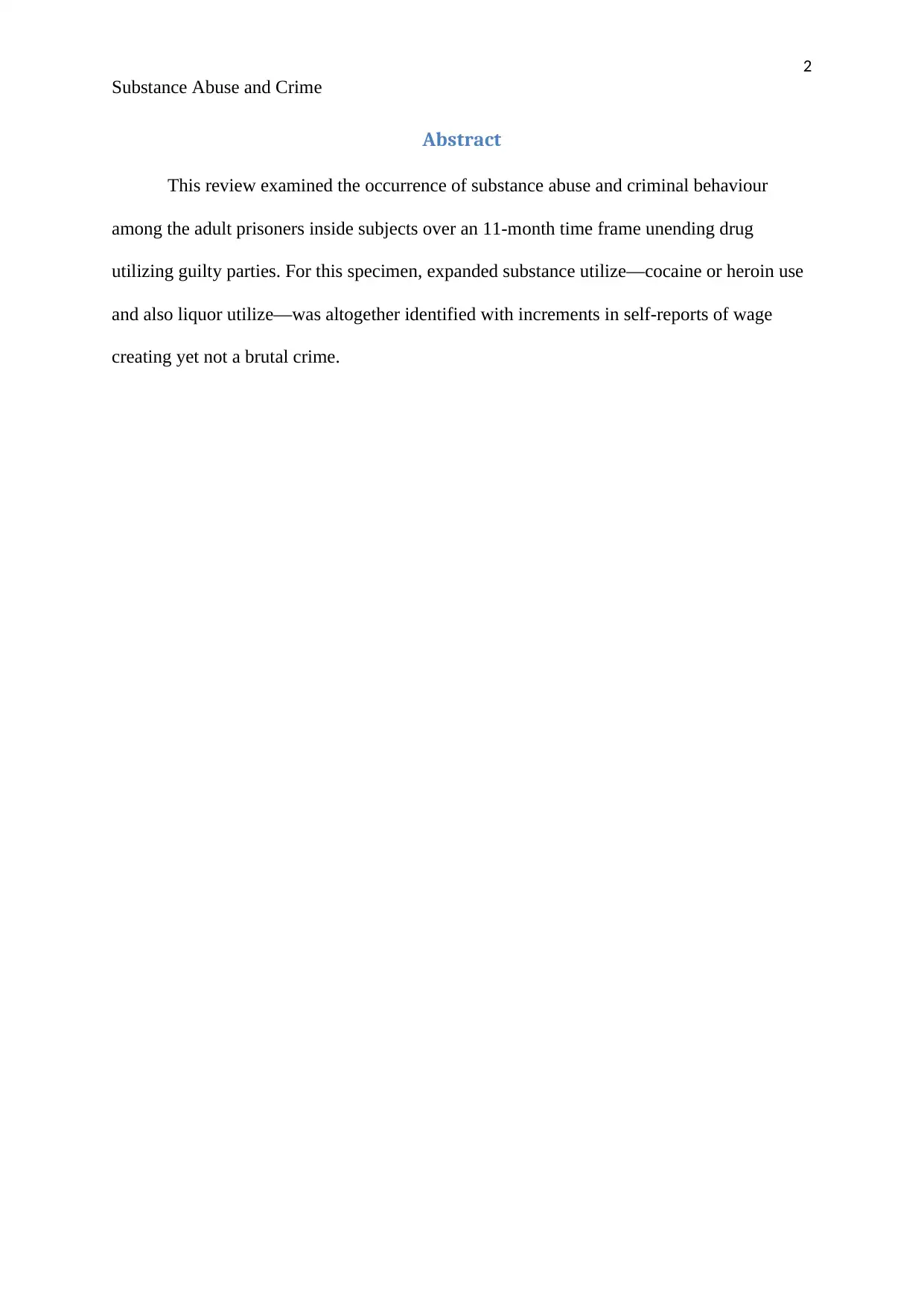
2
Substance Abuse and Crime
Abstract
This review examined the occurrence of substance abuse and criminal behaviour
among the adult prisoners inside subjects over an 11-month time frame unending drug
utilizing guilty parties. For this specimen, expanded substance utilize—cocaine or heroin use
and also liquor utilize—was altogether identified with increments in self-reports of wage
creating yet not a brutal crime.
Substance Abuse and Crime
Abstract
This review examined the occurrence of substance abuse and criminal behaviour
among the adult prisoners inside subjects over an 11-month time frame unending drug
utilizing guilty parties. For this specimen, expanded substance utilize—cocaine or heroin use
and also liquor utilize—was altogether identified with increments in self-reports of wage
creating yet not a brutal crime.
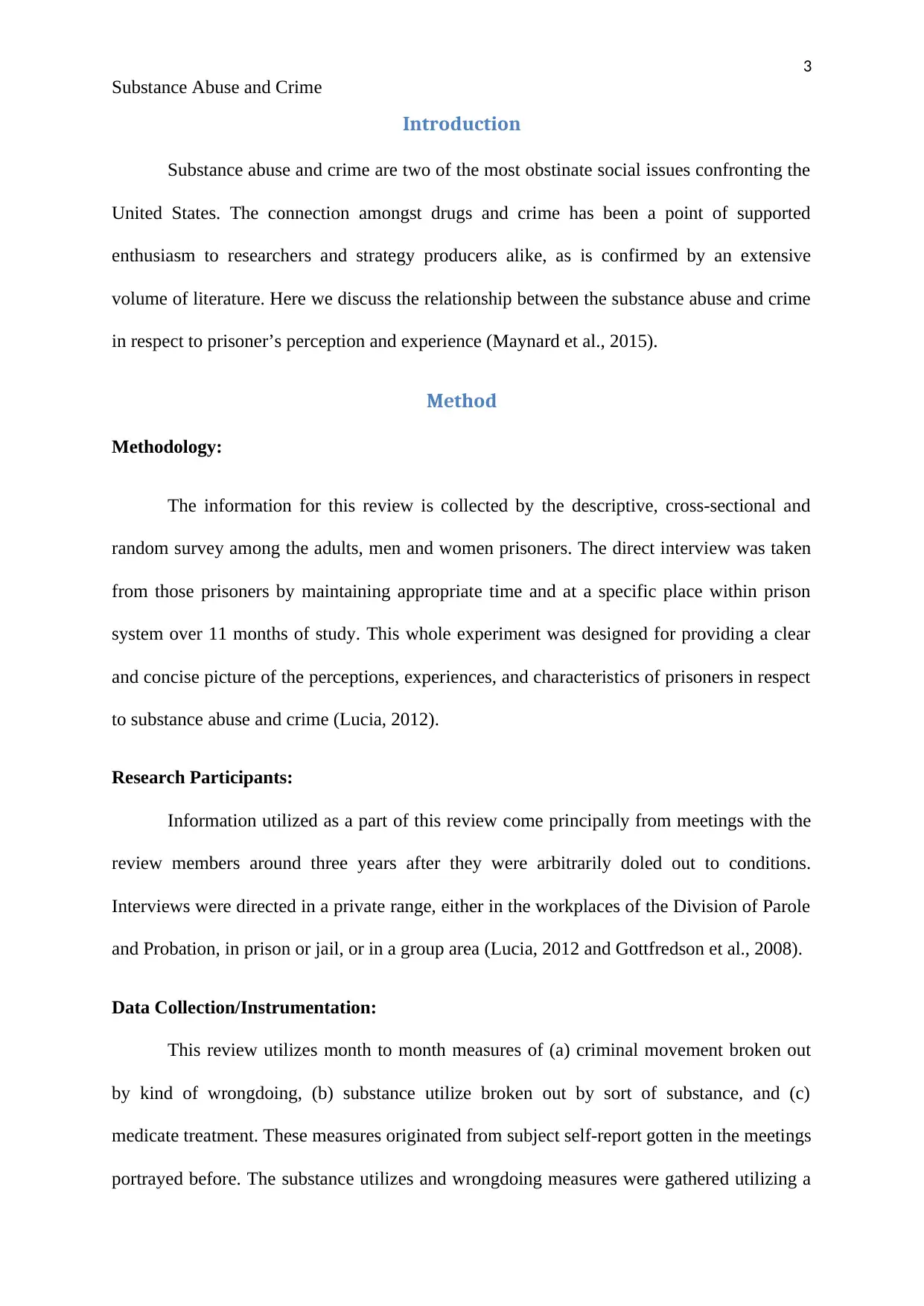
3
Substance Abuse and Crime
Introduction
Substance abuse and crime are two of the most obstinate social issues confronting the
United States. The connection amongst drugs and crime has been a point of supported
enthusiasm to researchers and strategy producers alike, as is confirmed by an extensive
volume of literature. Here we discuss the relationship between the substance abuse and crime
in respect to prisoner’s perception and experience (Maynard et al., 2015).
Method
Methodology:
The information for this review is collected by the descriptive, cross-sectional and
random survey among the adults, men and women prisoners. The direct interview was taken
from those prisoners by maintaining appropriate time and at a specific place within prison
system over 11 months of study. This whole experiment was designed for providing a clear
and concise picture of the perceptions, experiences, and characteristics of prisoners in respect
to substance abuse and crime (Lucia, 2012).
Research Participants:
Information utilized as a part of this review come principally from meetings with the
review members around three years after they were arbitrarily doled out to conditions.
Interviews were directed in a private range, either in the workplaces of the Division of Parole
and Probation, in prison or jail, or in a group area (Lucia, 2012 and Gottfredson et al., 2008).
Data Collection/Instrumentation:
This review utilizes month to month measures of (a) criminal movement broken out
by kind of wrongdoing, (b) substance utilize broken out by sort of substance, and (c)
medicate treatment. These measures originated from subject self-report gotten in the meetings
portrayed before. The substance utilizes and wrongdoing measures were gathered utilizing a
Substance Abuse and Crime
Introduction
Substance abuse and crime are two of the most obstinate social issues confronting the
United States. The connection amongst drugs and crime has been a point of supported
enthusiasm to researchers and strategy producers alike, as is confirmed by an extensive
volume of literature. Here we discuss the relationship between the substance abuse and crime
in respect to prisoner’s perception and experience (Maynard et al., 2015).
Method
Methodology:
The information for this review is collected by the descriptive, cross-sectional and
random survey among the adults, men and women prisoners. The direct interview was taken
from those prisoners by maintaining appropriate time and at a specific place within prison
system over 11 months of study. This whole experiment was designed for providing a clear
and concise picture of the perceptions, experiences, and characteristics of prisoners in respect
to substance abuse and crime (Lucia, 2012).
Research Participants:
Information utilized as a part of this review come principally from meetings with the
review members around three years after they were arbitrarily doled out to conditions.
Interviews were directed in a private range, either in the workplaces of the Division of Parole
and Probation, in prison or jail, or in a group area (Lucia, 2012 and Gottfredson et al., 2008).
Data Collection/Instrumentation:
This review utilizes month to month measures of (a) criminal movement broken out
by kind of wrongdoing, (b) substance utilize broken out by sort of substance, and (c)
medicate treatment. These measures originated from subject self-report gotten in the meetings
portrayed before. The substance utilizes and wrongdoing measures were gathered utilizing a
⊘ This is a preview!⊘
Do you want full access?
Subscribe today to unlock all pages.

Trusted by 1+ million students worldwide
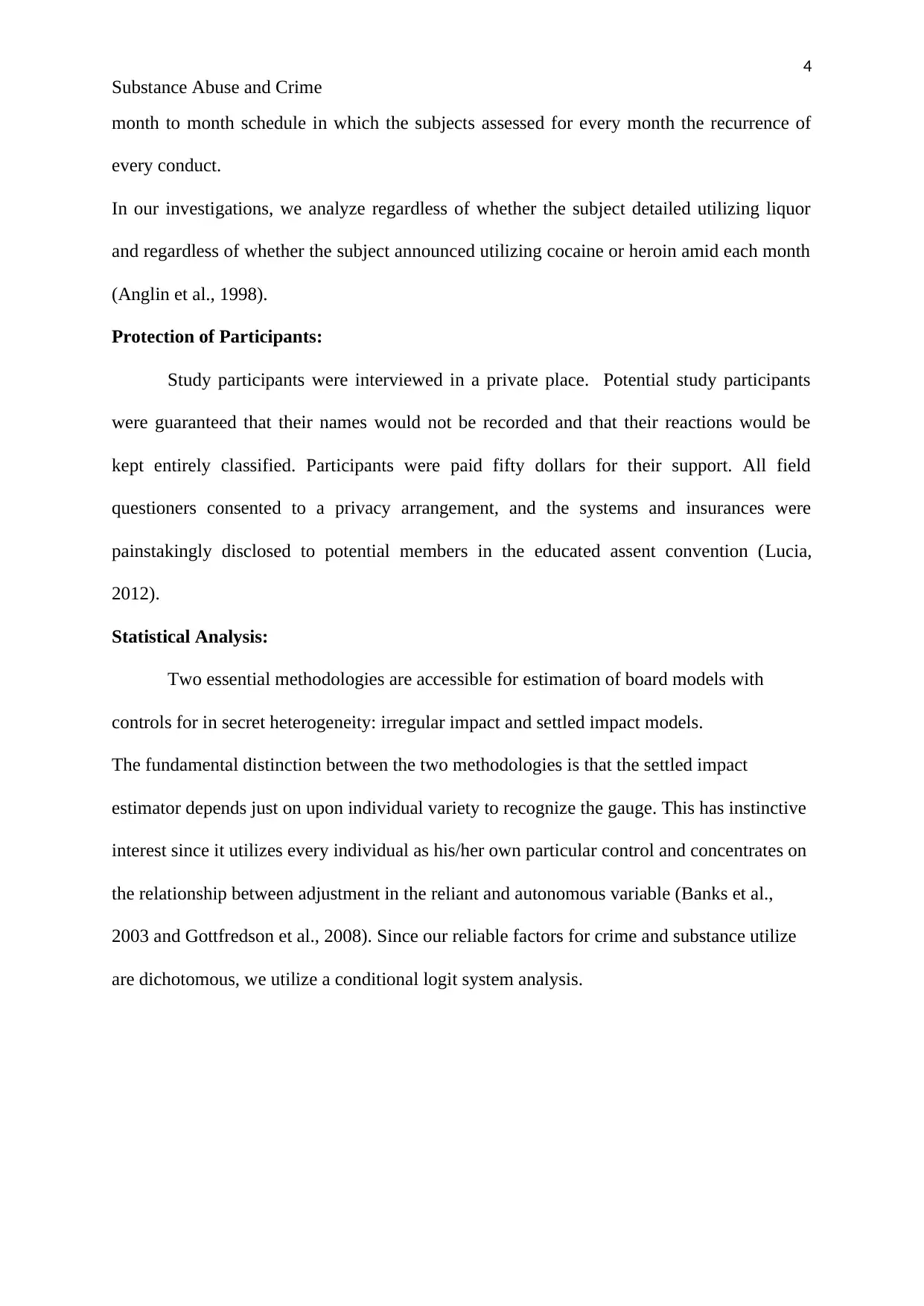
4
Substance Abuse and Crime
month to month schedule in which the subjects assessed for every month the recurrence of
every conduct.
In our investigations, we analyze regardless of whether the subject detailed utilizing liquor
and regardless of whether the subject announced utilizing cocaine or heroin amid each month
(Anglin et al., 1998).
Protection of Participants:
Study participants were interviewed in a private place. Potential study participants
were guaranteed that their names would not be recorded and that their reactions would be
kept entirely classified. Participants were paid fifty dollars for their support. All field
questioners consented to a privacy arrangement, and the systems and insurances were
painstakingly disclosed to potential members in the educated assent convention (Lucia,
2012).
Statistical Analysis:
Two essential methodologies are accessible for estimation of board models with
controls for in secret heterogeneity: irregular impact and settled impact models.
The fundamental distinction between the two methodologies is that the settled impact
estimator depends just on upon individual variety to recognize the gauge. This has instinctive
interest since it utilizes every individual as his/her own particular control and concentrates on
the relationship between adjustment in the reliant and autonomous variable (Banks et al.,
2003 and Gottfredson et al., 2008). Since our reliable factors for crime and substance utilize
are dichotomous, we utilize a conditional logit system analysis.
Substance Abuse and Crime
month to month schedule in which the subjects assessed for every month the recurrence of
every conduct.
In our investigations, we analyze regardless of whether the subject detailed utilizing liquor
and regardless of whether the subject announced utilizing cocaine or heroin amid each month
(Anglin et al., 1998).
Protection of Participants:
Study participants were interviewed in a private place. Potential study participants
were guaranteed that their names would not be recorded and that their reactions would be
kept entirely classified. Participants were paid fifty dollars for their support. All field
questioners consented to a privacy arrangement, and the systems and insurances were
painstakingly disclosed to potential members in the educated assent convention (Lucia,
2012).
Statistical Analysis:
Two essential methodologies are accessible for estimation of board models with
controls for in secret heterogeneity: irregular impact and settled impact models.
The fundamental distinction between the two methodologies is that the settled impact
estimator depends just on upon individual variety to recognize the gauge. This has instinctive
interest since it utilizes every individual as his/her own particular control and concentrates on
the relationship between adjustment in the reliant and autonomous variable (Banks et al.,
2003 and Gottfredson et al., 2008). Since our reliable factors for crime and substance utilize
are dichotomous, we utilize a conditional logit system analysis.
Paraphrase This Document
Need a fresh take? Get an instant paraphrase of this document with our AI Paraphraser
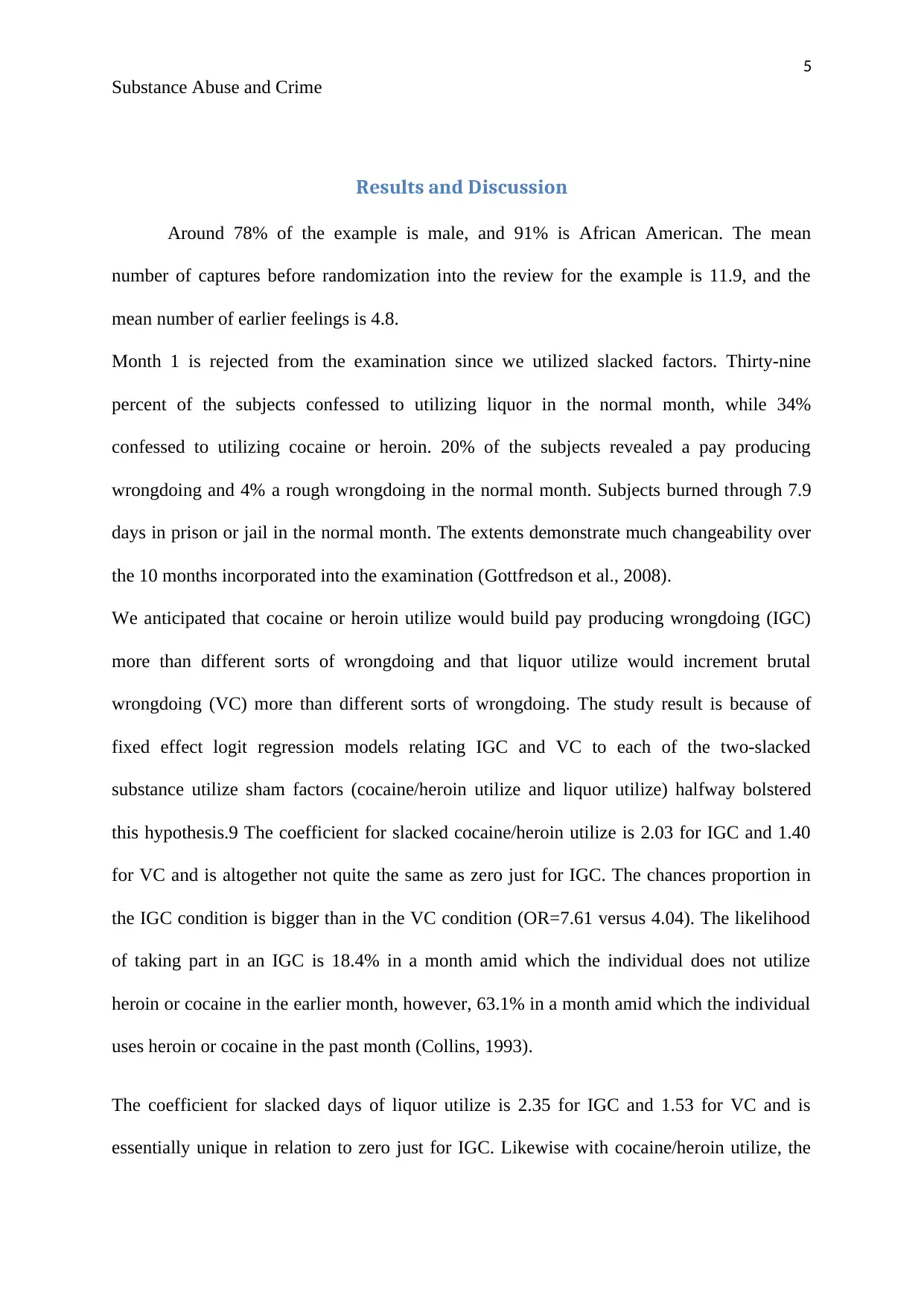
5
Substance Abuse and Crime
Results and Discussion
Around 78% of the example is male, and 91% is African American. The mean
number of captures before randomization into the review for the example is 11.9, and the
mean number of earlier feelings is 4.8.
Month 1 is rejected from the examination since we utilized slacked factors. Thirty-nine
percent of the subjects confessed to utilizing liquor in the normal month, while 34%
confessed to utilizing cocaine or heroin. 20% of the subjects revealed a pay producing
wrongdoing and 4% a rough wrongdoing in the normal month. Subjects burned through 7.9
days in prison or jail in the normal month. The extents demonstrate much changeability over
the 10 months incorporated into the examination (Gottfredson et al., 2008).
We anticipated that cocaine or heroin utilize would build pay producing wrongdoing (IGC)
more than different sorts of wrongdoing and that liquor utilize would increment brutal
wrongdoing (VC) more than different sorts of wrongdoing. The study result is because of
fixed effect logit regression models relating IGC and VC to each of the two-slacked
substance utilize sham factors (cocaine/heroin utilize and liquor utilize) halfway bolstered
this hypothesis.9 The coefficient for slacked cocaine/heroin utilize is 2.03 for IGC and 1.40
for VC and is altogether not quite the same as zero just for IGC. The chances proportion in
the IGC condition is bigger than in the VC condition (OR=7.61 versus 4.04). The likelihood
of taking part in an IGC is 18.4% in a month amid which the individual does not utilize
heroin or cocaine in the earlier month, however, 63.1% in a month amid which the individual
uses heroin or cocaine in the past month (Collins, 1993).
The coefficient for slacked days of liquor utilize is 2.35 for IGC and 1.53 for VC and is
essentially unique in relation to zero just for IGC. Likewise with cocaine/heroin utilize, the
Substance Abuse and Crime
Results and Discussion
Around 78% of the example is male, and 91% is African American. The mean
number of captures before randomization into the review for the example is 11.9, and the
mean number of earlier feelings is 4.8.
Month 1 is rejected from the examination since we utilized slacked factors. Thirty-nine
percent of the subjects confessed to utilizing liquor in the normal month, while 34%
confessed to utilizing cocaine or heroin. 20% of the subjects revealed a pay producing
wrongdoing and 4% a rough wrongdoing in the normal month. Subjects burned through 7.9
days in prison or jail in the normal month. The extents demonstrate much changeability over
the 10 months incorporated into the examination (Gottfredson et al., 2008).
We anticipated that cocaine or heroin utilize would build pay producing wrongdoing (IGC)
more than different sorts of wrongdoing and that liquor utilize would increment brutal
wrongdoing (VC) more than different sorts of wrongdoing. The study result is because of
fixed effect logit regression models relating IGC and VC to each of the two-slacked
substance utilize sham factors (cocaine/heroin utilize and liquor utilize) halfway bolstered
this hypothesis.9 The coefficient for slacked cocaine/heroin utilize is 2.03 for IGC and 1.40
for VC and is altogether not quite the same as zero just for IGC. The chances proportion in
the IGC condition is bigger than in the VC condition (OR=7.61 versus 4.04). The likelihood
of taking part in an IGC is 18.4% in a month amid which the individual does not utilize
heroin or cocaine in the earlier month, however, 63.1% in a month amid which the individual
uses heroin or cocaine in the past month (Collins, 1993).
The coefficient for slacked days of liquor utilize is 2.35 for IGC and 1.53 for VC and is
essentially unique in relation to zero just for IGC. Likewise with cocaine/heroin utilize, the
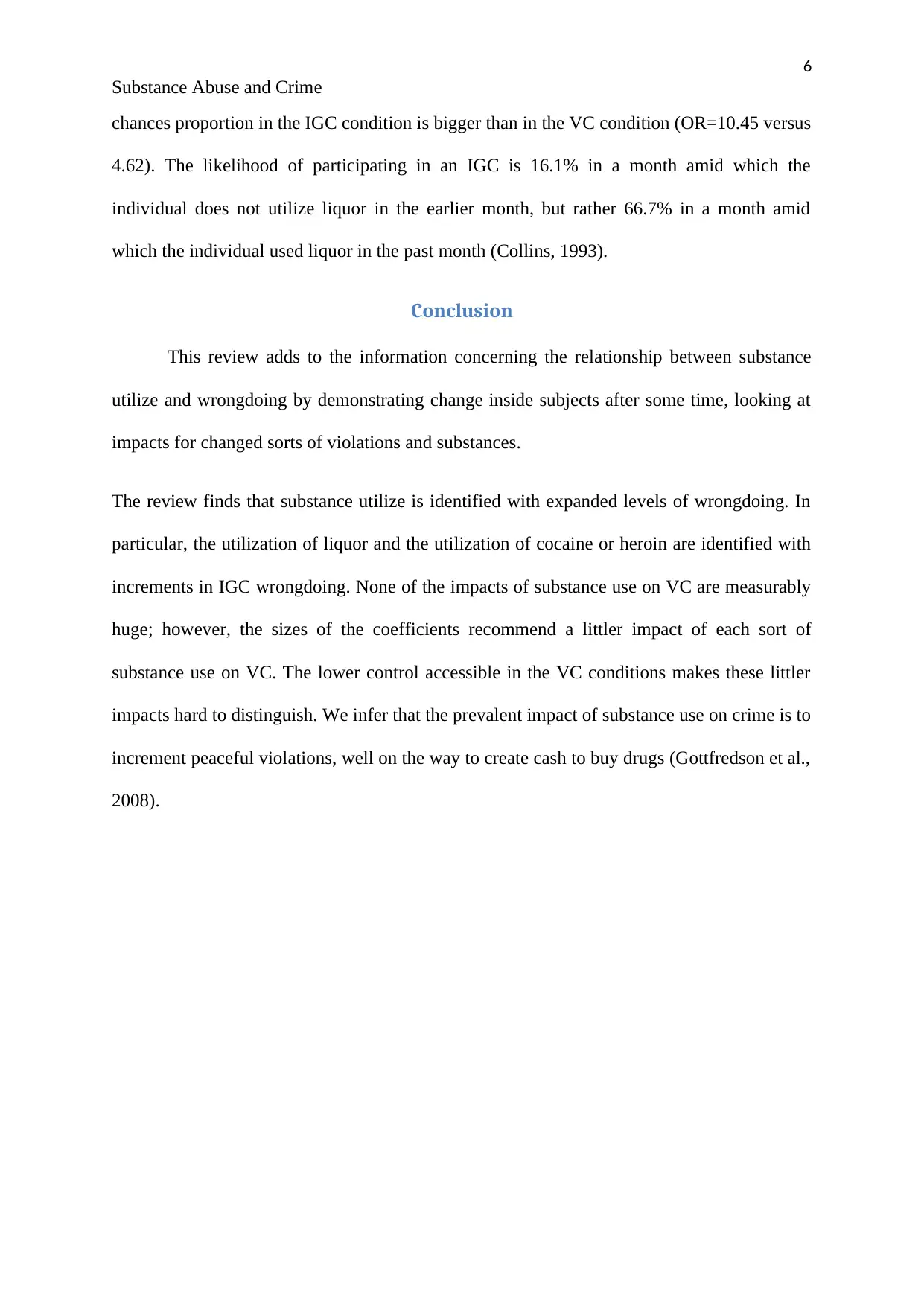
6
Substance Abuse and Crime
chances proportion in the IGC condition is bigger than in the VC condition (OR=10.45 versus
4.62). The likelihood of participating in an IGC is 16.1% in a month amid which the
individual does not utilize liquor in the earlier month, but rather 66.7% in a month amid
which the individual used liquor in the past month (Collins, 1993).
Conclusion
This review adds to the information concerning the relationship between substance
utilize and wrongdoing by demonstrating change inside subjects after some time, looking at
impacts for changed sorts of violations and substances.
The review finds that substance utilize is identified with expanded levels of wrongdoing. In
particular, the utilization of liquor and the utilization of cocaine or heroin are identified with
increments in IGC wrongdoing. None of the impacts of substance use on VC are measurably
huge; however, the sizes of the coefficients recommend a littler impact of each sort of
substance use on VC. The lower control accessible in the VC conditions makes these littler
impacts hard to distinguish. We infer that the prevalent impact of substance use on crime is to
increment peaceful violations, well on the way to create cash to buy drugs (Gottfredson et al.,
2008).
Substance Abuse and Crime
chances proportion in the IGC condition is bigger than in the VC condition (OR=10.45 versus
4.62). The likelihood of participating in an IGC is 16.1% in a month amid which the
individual does not utilize liquor in the earlier month, but rather 66.7% in a month amid
which the individual used liquor in the past month (Collins, 1993).
Conclusion
This review adds to the information concerning the relationship between substance
utilize and wrongdoing by demonstrating change inside subjects after some time, looking at
impacts for changed sorts of violations and substances.
The review finds that substance utilize is identified with expanded levels of wrongdoing. In
particular, the utilization of liquor and the utilization of cocaine or heroin are identified with
increments in IGC wrongdoing. None of the impacts of substance use on VC are measurably
huge; however, the sizes of the coefficients recommend a littler impact of each sort of
substance use on VC. The lower control accessible in the VC conditions makes these littler
impacts hard to distinguish. We infer that the prevalent impact of substance use on crime is to
increment peaceful violations, well on the way to create cash to buy drugs (Gottfredson et al.,
2008).
⊘ This is a preview!⊘
Do you want full access?
Subscribe today to unlock all pages.

Trusted by 1+ million students worldwide
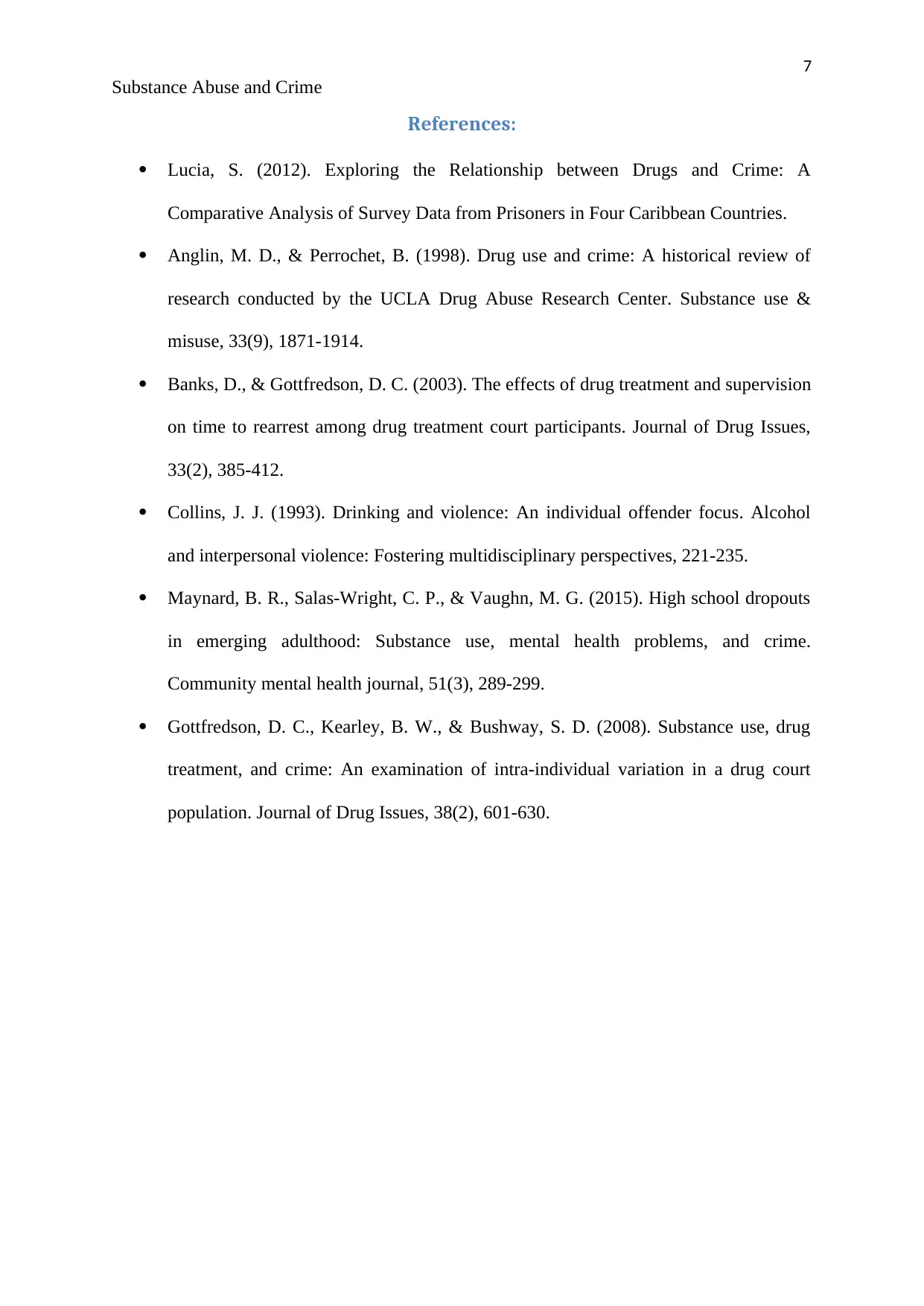
7
Substance Abuse and Crime
References:
Lucia, S. (2012). Exploring the Relationship between Drugs and Crime: A
Comparative Analysis of Survey Data from Prisoners in Four Caribbean Countries.
Anglin, M. D., & Perrochet, B. (1998). Drug use and crime: A historical review of
research conducted by the UCLA Drug Abuse Research Center. Substance use &
misuse, 33(9), 1871-1914.
Banks, D., & Gottfredson, D. C. (2003). The effects of drug treatment and supervision
on time to rearrest among drug treatment court participants. Journal of Drug Issues,
33(2), 385-412.
Collins, J. J. (1993). Drinking and violence: An individual offender focus. Alcohol
and interpersonal violence: Fostering multidisciplinary perspectives, 221-235.
Maynard, B. R., Salas-Wright, C. P., & Vaughn, M. G. (2015). High school dropouts
in emerging adulthood: Substance use, mental health problems, and crime.
Community mental health journal, 51(3), 289-299.
Gottfredson, D. C., Kearley, B. W., & Bushway, S. D. (2008). Substance use, drug
treatment, and crime: An examination of intra-individual variation in a drug court
population. Journal of Drug Issues, 38(2), 601-630.
Substance Abuse and Crime
References:
Lucia, S. (2012). Exploring the Relationship between Drugs and Crime: A
Comparative Analysis of Survey Data from Prisoners in Four Caribbean Countries.
Anglin, M. D., & Perrochet, B. (1998). Drug use and crime: A historical review of
research conducted by the UCLA Drug Abuse Research Center. Substance use &
misuse, 33(9), 1871-1914.
Banks, D., & Gottfredson, D. C. (2003). The effects of drug treatment and supervision
on time to rearrest among drug treatment court participants. Journal of Drug Issues,
33(2), 385-412.
Collins, J. J. (1993). Drinking and violence: An individual offender focus. Alcohol
and interpersonal violence: Fostering multidisciplinary perspectives, 221-235.
Maynard, B. R., Salas-Wright, C. P., & Vaughn, M. G. (2015). High school dropouts
in emerging adulthood: Substance use, mental health problems, and crime.
Community mental health journal, 51(3), 289-299.
Gottfredson, D. C., Kearley, B. W., & Bushway, S. D. (2008). Substance use, drug
treatment, and crime: An examination of intra-individual variation in a drug court
population. Journal of Drug Issues, 38(2), 601-630.
1 out of 7
Related Documents
Your All-in-One AI-Powered Toolkit for Academic Success.
+13062052269
info@desklib.com
Available 24*7 on WhatsApp / Email
![[object Object]](/_next/static/media/star-bottom.7253800d.svg)
Unlock your academic potential
Copyright © 2020–2025 A2Z Services. All Rights Reserved. Developed and managed by ZUCOL.



